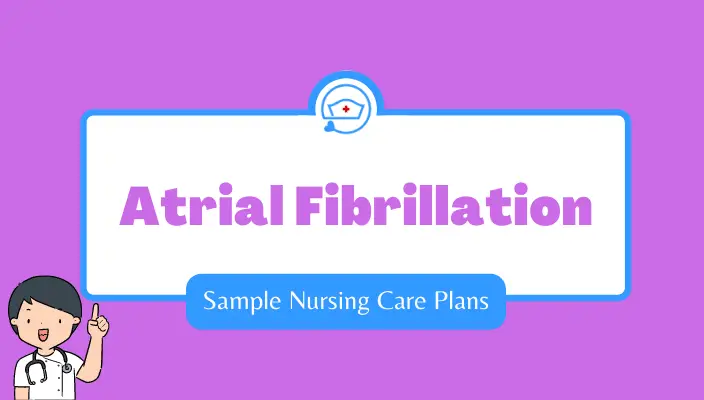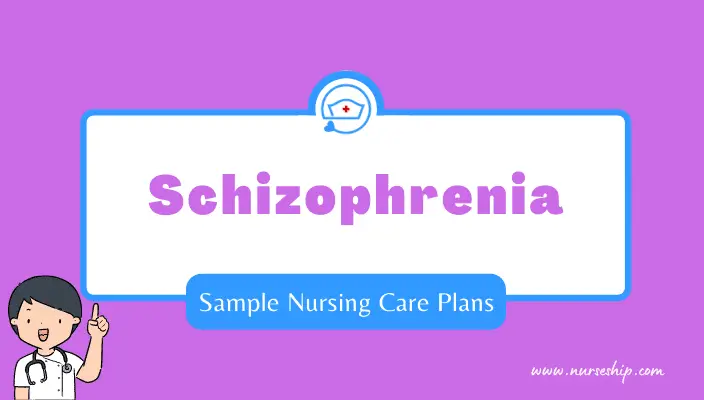Sample Nursing Care Plan for CHF [Congestive Heart Failure]
What is congestive heart failure?
Heart failure is a chronic, progressive condition. It occurs when the heart is unable to pump effectively and produce enough cardiac output to successfully perfuse the rest of the body’s tissues and organs. An individual can have right-sided or left-sided heart failure as well as systolic or diastolic heart failure.
Left-sided heart failure is also known as Congestive Heart Failure (CHF). In CHF, the heart is either unable to contract completely or fill completely during relaxation. It can lead to an inadequate amount of blood pumping out of the heart. Thereby, backing up into the right side and then ultimately to the lungs and throughout the body causing congestion.
Systolic heart failure means the heart is not able to contract completely and affects its ability to pump blood out of the heart.
Diastolic heart failure means the heart is unable to relax fully between heartbeats and allows the appropriate amount of blood into the ventricle.
In this post, we’ll formulate a sample nursing care plan for a patient with Congestive Heart Failure (CHF) based on a hypothetical case scenario.
CHF Case Scenario
A 74-year old Hispanic male presents to the Emergency Department with complaints of increased dyspnea, reduced activity tolerance, ankle swelling, and weight gain in recent days. He has a known history of hypertension and heart failure. He reports over the past 3 days his shortness of breath, particularly with activity, has increased significantly.
He is also now using 3 pillows to sleep at night instead of his usual 1 pillow, and he has experienced a 10-pound weight gain in 3 days. He states he is now only able to ambulate 1 block before needing to stop and rest whereas in the past he could walk half a mile.
The nurse notes dyspnea upon minimal excretion with position changes. Upon physical assessment his breathing is shallow and labored, respiratory rate is 30 breaths per minute, heart rate 115 beats per minute, oxygen saturation 83% on room air, blood pressure 179/98 mm Hg, he has +4 pitting edema in bilateral lower extremities, and crackles are heard in his lung fields throughout.
The patient’s lab work reveals an elevated BNP level of 954pg/mL and a chest x-ray shows pulmonary congestion. The last echocardiogram in the patient’s chart (completed 3 months prior) showed an Ejection Fraction (EF) of 40%.
The patient is to be admitted to the hospital for Acute Exacerbation of Congestive Heart Failure (CHF).
Case Discussion
The main assessment findings the nurse should be aware of for this patient begin with his vital signs, all of which are listed are abnormal.
The patient has labored, tachypneic, breathing. He is also tachycardic and has a decreased oxygen saturation. This demonstrates to the nurse that the patient is not hemodynamically stable and the main goal is stabilizing the patient’s respiratory status.
In addition, the nurse should also note the reported weight gain and visibly apparent edema. These assessment findings are able to help the nurse critically think and identify a potential list of differential diagnoses prior to lab and imaging results becoming available.
When assessing this patient, the nurse will want to remember ABCs (airway, breathing, circulation) of care. The patient’s airway is protected and he is able to breathe on his own.
However, his breathing is compromised due to excessive fluid. Therefore, that becomes the priority for the patient and the nurse should begin by improving his oxygen saturation and breathing status.
Once the patient’s breathing status is stabilized the next likely task will be to diuresis the patient. In doing this, it will help to remove additional fluid thereby improving his oxygen and breathing capability further.
#1 Sample nursing care plan for CHF – Impaired gas exchange
Nursing Assessment
Subjective Data:
- Reported increased shortness of breath
- Using 3 pillows to sleep at night (increase from usual 1 pillow)
- Decreased activity level due to shortness of breath
Objective Data:
- Tachypneic, respiratory rate of 30 breaths/minute
- Crackles in lung fields
- Oxygen saturation 83% on room air
- Congestion on chest x-ray
- +4 pitting edema
Nursing Diagnosis [Impaired gas exchange]
Impaired gas exchange related to fluid overload as evidenced by labored, tachypneic breathing, decreased oxygen saturation, crackles in lung fields, pitting edema, congestion on chest x-ray.
Short-term goal
To increase oxygen saturation ≥92% prior to transfer from ED and admission to hospital floor unit
Nursing Interventions with Rationales
| Interventions | Rationales |
| Administer supplemental oxygen therapy with continuous oxygen saturation monitoring | Supplemental oxygen will increase alveolar oxygen concentration |
| Maintain chair/bedrest | Rest will reduce the body’s oxygen demands and consumption |
| Position patient into Semi-Fowler’s position | Positioning will allow for maximal lung expansion and inflation |
Long-term goal
To decrease excess fluid by 10 pounds by discharge to return patient to baseline dry weight
Nursing Interventions with Rationales
| Interventions | Rationales |
| Administer medications as ordered (diuretics) | Diuretics will pull off excess fluid within the body thereby reducing congestion |
| Initiate fluid restriction | The fluid restriction will prevent additional fluid accumulation |
| Monitor intake and output (I&O) closely | I&O monitoring will allow for assessment of progress made with the administration of diuretics and fluid restriction |
Expected Outcome
- This will reduce hypoxemia resulting in improved oxygen saturation and reduce dyspnea.
- Excess fluid will be removed and the patient’s weight will return to baseline.
- Reduced congestion will improve gas exchange.
#2 Sample nursing care plan for CHF – Decreased cardiac output
Nursing Assessment
Subjective Data:
- Needs 3 pillows at night to sleep
- 10-pound weight gain
- Ankle swelling
Objective Data:
- Tachycardia
- Hypertension
- +4 pitting edema
- Crackles in lung fields throughout
- Ejection fraction (EF) 40%
- Elevated BNP 954pg/mL
- Congestion seen on chest x-ray
Nursing Diagnosis [Decreased cardiac output]
Decreased cardiac output related to altered contractility as evidenced by tachycardia, hypertension, orthopnea, edema, abnormal lab work, and reduced EF.
Short-term goal
To stabilize vital signs and maintain adequate oxygen saturation prior to transfer from ED to the hospital unit.
Nursing Interventions with Rationales
| Interventions | Rationales |
| Administer supplemental oxygen therapy | Oxygen therapy will increase the available oxygen in the body for the myocardium and correct hypoxia |
| Administer antihypertensive medication as ordered | Antihypertensive medications will reduce the patient’s elevated blood pressure thereby reducing the additional stress on the heart |
Long-term goal
To improve cardiac contractility by discharge
Nursing Interventions with Rationales
| Interventions | Rationales |
| Administer medications as ordered (diuretics, ACE, and ARBs) | Diuretics will decrease excess fluid and stress on the cardiac muscle ACE inhibitors will increase cardiac output. ARBs can assist with decreasing blood pressure and when used in combination with ACE inhibitors can have cardioprotective effects |
| Monitor I&O closely | I&O should be monitored closely to successfully and accurately record the progress of treatment |
Expected Outcome
- Maintain oxygen saturation above 92%
- Decrease in blood pressure to patient’s baseline (ideally <120/80)
- Improved contractility by decreasing excess fluid, improvement in breathing status, and stabilization of vital signs
#3 Sample nursing care plan for CHF – Decreased activity tolerance
Nursing Assessment
Subjective Data:
- Only able to ambulate 1 block
- Reduced activity level
Objective Data:
- Dyspnea on minimal exertion
- Tacypnea (RR 30 bpm)
- Tachycardia (PR 115 bpm)
- Decreased oxygen saturation (83% at room air)
Nursing Diagnosis [Decreased activity tolerance]
Decreased activity tolerance related to imbalance between oxygen supply and demand as evidenced by dyspnea, tachypnea, tachycardia, decreased oxygen saturation, and fatigue.
Short-term goal
To limit activity to decrease oxygen demand while also increasing oxygen supply
Nursing Interventions with Rationales
| Interventions | Rationales |
| Maintain chair/bedrest in semi-Fowler’s position | Chair/bedrest will limit the body’s oxygen demand beyond the usual requirements. Semi-Fowler’s position will allow for optimal oxygen usage by the body. |
| Administer supplemental oxygen | Oxygen therapy will increase the supply of oxygen presently demanded by the body |
Long-term goal
To increase activity level to patient’s baseline prior to discharge.
Nursing Interventions with Rationales
| Interventions | Rationales |
| Assist patient with ADLs as needed; Provide physical therapy exercises; Implement cardiac rehabilitation program and activity plan | These interventions will assist the patient with completing activities and will help to build the patient’s strength and endurance back to baseline |
Expected Outcome
- Improved oxygenation status (≥92%)
- Patient’s activity level will return to baseline
Bonus Tips
It is vital to monitor patients admitted with congestive heart failure closely. In particular, detailed and accurate intake and output records should be kept to show the progress and success of treatments being administered.
This will also help to determine if additional medications are warranted or dosage adjustments need to be made.
Close monitoring of types of food and drinks is also important. Because some food may cause patient to retain more fluid than others. Providing proper patient education is key for these patients to support them in understanding their condition and diagnosis.
Likewise, education will help the patient to be aware of specific things to avoid at home in terms of food or drink and why these should be avoided.
Click here to see a full list of Nursing Diagnoses related to Congestive Heart Failure (CHF).
Conclusion
Congestive heart failure is a chronic condition that can progress over time. Acute exacerbations of this chronic condition can also be very common especially if an individual is not following or is unaware of the appropriate guidelines and recommendations.
It is important for nurses to understand the various symptoms a patient may present with when experiencing an acute exacerbation. It is also imperative that the nurse assesses the individual’s airway and breathing status immediately and prioritizes this above any other nursing intervention.
Lastly, providing thorough patient education both verbally and in writing is essential for these individuals to help them understand their diagnosis and what measures they can take at home to prevent additional exacerbations.
Reference
Ackley, B.J., Ladwig, G.B., Flynn-Makic, M.B., Martinez-Kratz, M.R., & Zanotti, M. (2020). Nursing Diagnosis Handbook: An Evidence-based Guide to Planning Care [eBook edition]. Elsevier.
Comer, S. and Sagel, B. (1998). CRITICAL CARE NURSING CARE PLANS. Skidmore-Roth Publications.
Doenges, M.E., Moorhouse, M.F., & Murr, A.C. (2019). Nursing Care Plan: Guidelines for Individualizing Client Care Across the Lifespan [eBook edition]. F.A. Davis Company.
Herdman, T., Kamitsuru, S. & Lopes, C. (2021). NURSING DIAGNOSES: Definitions and Classifications 2021-2023 (12th ed.). Thieme.




